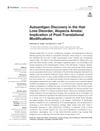Search
forLearn
5 / 25 resultslearn Osteopontin
signaling protein that, when suppressed, may grow hair by reducing inflammation and stem cell loss
learn Thymosin Beta 4
learn sh-Polypeptide-7
learn Stem Cell Factor
Research
5 / 1000+ resultsresearch Characterization of Hair Follicle Antigens Targeted by the Anti-Hair Follicle Immune Response
Alopecia areata is an autoimmune disorder causing hair loss, linked to specific hair follicle antigens and genetic factors.
research Identification of Human Hair Follicle Antigens Targeted in the Presumptive Autoimmune Hair Follicle Disorder Alopecia Areata and Their Potential Functional Relevance In Vitro: Methods Development for Isolation and Identification of Alopecia Areata-Relevant Human Hair Follicle Antigens Using a Proteomics Approach and Their Functional Assessment Using an Ex Vivo Hair Follicle Organ Culture Model
Alopecia areata may be caused by antibodies targeting specific hair follicle proteins, hindering hair growth.
research Trichohyalin Is a Potential Major Autoantigen in Human Alopecia Areata
Trichohyalin may trigger the immune response causing alopecia areata.

research Autoantigen Discovery in the Hair Loss Disorder, Alopecia Areata: Implications of Post-Translational Modifications
New protein changes may be involved in the immune attack on hair follicles in alopecia areata.

research Immune Niches for Hair Follicle Development and Homeostasis
Immune cells are crucial for hair growth and preventing hair loss.
Community Join
5 / 420 resultscommunity Summary of Procapil video by Haircafe
Procapil is marketed as a natural hair loss treatment but lacks strong evidence and is industry-biased. Minoxidil and Finasteride are the only FDA-approved treatments for androgenetic alopecia.
community Weed/THC effects on hair growth/hair loss, and vitality of organ-culture human follicle studies (research review)
Cannabis and THC may have mixed effects on hair, with some studies suggesting potential negative impacts on hair growth in isolated hair follicles, but these results are hard to apply to living humans. Treatments like minoxidil and finasteride are commonly used for hair loss, and the effects of cannabis might be neutral or vary based on individual factors.
community Solving Hair Loss with Research at MIT
Hair loss treatments like minoxidil, finasteride, TDM-105795, and PP405. MIT is hosting a hackathon to find innovative hair loss solutions.
community PP405 Won't Work Long Term: Hair Follicle Damage Due to Abuse of the ISR System
PP405 may damage hair follicles if used long-term, suggesting cycling might be necessary. Combining it with finasteride could help maintain hair growth.
community Predict if You'll Shed and Responding to Treatment: Ultrasound Imaging Technology
Ultrasound imaging can predict hair shedding and assess hair growth stages by analyzing hair follicle characteristics. The conversation also discusses using ultrasound for personal hair analysis and mentions the potential use of infrared emission for hair treatment.